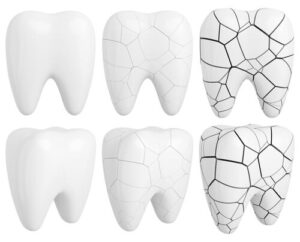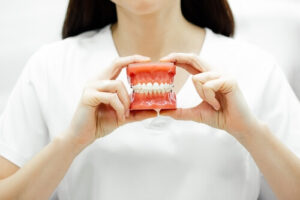Dealing with a root canal-cracked tooth can be daunting, filled with concerns about pain, treatment options, and the long-term health of your tooth. This common dental issue causes discomfort and poses a risk to your oral health if left unaddressed. Fortunately, modern dentistry offers effective solutions for restoring the integrity and functionality of a cracked tooth through root canal therapy.
In this article, we’ll dive into the intricacies of treating a root canal cracked tooth, exploring how this procedure can alleviate pain, prevent further damage, and ultimately save your tooth.
Root Canal Cracked Tooth: Understanding the Basics
A cracked tooth can vary significantly in location, severity, and symptoms, making it essential to grasp the underlying causes and potential treatments of a cracked root canal tooth. The root canal procedure is pivotal in saving teeth that might otherwise require extraction, effectively eliminating pain and restoring the tooth’s function.
Types of Cracked Teeth
Cracks can range from minor craze lines in the enamel to vertical root fractures extending to the gum line, each with specific implications for treatment.
Symptoms to Watch For
Identifying a cracked tooth early often involves recognizing erratic pain when chewing or sensitivity to temperature changes, which is crucial for timely treatment.
Root Canal Therapy
This procedure is essential for tooth extractions. For teeth with cracks reaching the pulp, it removes damaged tissue to alleviate pain and prevent further decay or infection.
Treatment Outcomes
Successfully treated cracked teeth with root canals can last a lifetime with proper care, emphasizing the procedure’s effectiveness in preserving dental health.
Prevention and Maintenance
Understanding the causes of tooth fractures, such as biting on hard objects or tooth grinding, can help prevent future incidents, alongside regular dental check-ups.
Symptoms of Cracked Tooth Needing a Root Canal
Identifying the symptoms of a cracked tooth needing a root canal is crucial for timely and effective treatment. A cracked tooth can manifest a range of symptoms that signal the need for immediate dental attention, particularly when the integrity of the tooth’s inner pulp is compromised.
Pain When Chewing or Biting: One of the hallmark symptoms of a cracked tooth requiring a root canal is sharp pain upon chewing or applying pressure, indicating that the crack may have extended into the pulp or surrounding bone.
Sensitivity to Hot and Cold: Heightened sensitivity to hot and cold temperatures typically indicates that the tooth’s nerves and blood vessels are impacted.
Swelling of the Gum Around the Tooth: Swelling or tenderness in the gum surrounding the vertical root of the cracked tooth can be a sign of infection that has reached the tooth’s root.
Discoloration of the Tooth: A cracked tooth needing a root canal may exhibit discoloration, indicating damage to the failed root canal to the inner tooth structures.
Persistent Pain or Discomfort: Continuous pain or discomfort, especially if it interferes with daily activities, indicates that the tooth requires professional evaluation and possibly a root canal.
The Root Canal Procedure: Step-by-Step Guide for Cracked Teeth

The root canal procedure is a critical treatment for saving cracked teeth that have suffered damage extending to the tooth’s pulp. This step-by-step guide outlines the essential phases of the root canal process, designed to remove infected or damaged tissue, alleviate pain, and restore the tooth’s function and health.
Diagnosis and X-ray: The process begins with a thorough examination, and X-rays are used to determine the extent of the tooth’s damage and plan the treatment.
Anesthesia: Local anesthesia is applied to numb the area, guaranteeing the patient’s comfort during the procedure.
Access Opening: A small opening in the tooth’s chewing surface, and the tooth’s crown is broken to access the damaged pulp.
Pulp Removal: The damaged or infected pulp is meticulously extracted from the pulp chamber and root canals.
Cleaning and Shaping: The canals are then cleaned and shaped to prepare them for the filling material.
Filling the Canals: The cleaned canals are filled with a biocompatible material, usually gutta-percha, to seal the tooth and prevent reinfection.
Restoration: Finally, the tooth is restored with a filling or crown to protect the broken tooth and restore its natural function and appearance.
Post-Treatment Care: Ensuring the Best Outcome for Your Tooth

Post-treatment care following a root canal procedure is paramount to ensuring the best outcome for your treated tooth. Proper care and attention to the treated area can significantly impact the healing process, prevent complications, and contribute to the longevity of the tooth’s restoration.
Pain Management: Some discomfort or sensitivity is normal initially. Over-the-counter pain relievers or prescribed medications can help manage this.
Oral Hygiene: Maintaining excellent oral hygiene, including gentle brushing and flossing around the treated area, is crucial to prevent infection.
Avoiding Pressure: To prevent further damage, patients are advised not to chew on the treated tooth until it has been completely restored with a permanent filling or crown.
Monitoring for Changes: Watching for signs of infection or unusual symptoms and contacting the dentist if anything seems amiss is important.
Regular Dental Visits: Follow-up visits enable the dentist to oversee the healing process and confirm the success of the root canal treatment and restoration.
Preventing Future Cracks: Tips for Maintaining Strong Teeth After a Root Canal

A root canal-treated tooth, particularly one cracked, requires special care to prevent further damage and ensure its strength and functionality. Implementing specific practices can significantly reduce the risk of future cracks and other dental issues, safeguarding the health of both the treated tooth and surrounding teeth.
Use of Night Guards: For individuals prone to grinding or clenching their teeth, a night guard can protect them from excessive wear and potential cracks.
Avoiding Hard Foods: Steering clear of hard, crunchy, or sticky foods can prevent undue stress on teeth, reducing the risk of cracks.
Proper Oral Hygiene: Regular brushing with fluoride toothpaste, flossing, and utilizing antiseptic mouthwash are key practices in maintaining strong teeth and a healthy oral environment.
Regular Dental Check-ups: Routine visits to the dentist for check-ups and cleanings allow for early detection of potential problems and the maintenance of dental restorations.
Mindful Chewing: Not using teeth as tools and avoiding chewing on non-food items can prevent accidental damage.
In conclusion, promptly and effectively addressing a root canal cracked tooth is crucial for preserving your dental health and preventing further complications. Through the root canal procedure, dentists can repair and save a tooth that might otherwise be lost to damage or decay. Understanding the importance of this treatment helps alleviate concerns and prepares individuals for what to expect during and after the procedure. Following proper post-treatment care and implementing preventive measures, patients can enjoy a strong, healthy smile for years. Early intervention is key when dealing with a root canal cracked tooth, ensuring the best possible outcome and minimizing the risk of future dental issues.
References
Cracked Teeth – American Association of Endodontists
Cracked Teeth
Fractured Tooth (Cracked Tooth): What It Is, Symptoms
https://my.clevelandclinic.org/health/diseases/21628-fractured-tooth-cracked-tooth
Cracked Tooth: Symptoms, Treatments, and Recovery
https://www.healthline.com/health/cracked-tooth
Cracked tooth: Symptoms, diagnosis, and treatment
https://www.medicalnewstoday.com/articles/322015
Root canal treatment
https://www.healthdirect.gov.au/root-canal-treatment

